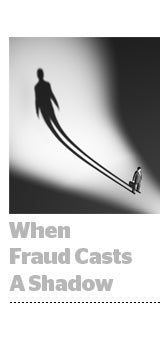 Many publishers don’t know – or don’t want to know – what kind of fraud occurs on their sites.
Many publishers don’t know – or don’t want to know – what kind of fraud occurs on their sites.
But it’s a reaction not dissimilar to how brands approached fraud before shocking numbers – like the 17% of programmatic ads and 23% of video ads determined fraudulent in the ANA/White Ops study last year – woke brands up. Another finding from that study: 52% of sourced traffic – traffic many publishers pay for – was fraudulent.
Fraudsters take money from advertiser budgets that should go to publishers attracting real, high-quality audiences. Fake URLs show up on exchanges and harm publisher brand names. The value of having a clean site is only going to go up if advertisers demand to pay only for human traffic. And publishers can abet fraud themselves depending on how they source traffic.
Buying Traffic Often Means Buying Bots
“Just don’t do it,” said Augustine Fou, a Ph.D. consultant who specializes in anti-fraud forensic science and whose clients include brands in the CPG and high-tech spaces. “Among the good publishers that I serve, all of them have policies not to buy traffic of any kind and it shows in the data that their bot problem is very low.
WhiteOps CEO Michael Tiffany agreed, noting there are “giant differences” in terms of how stringently the various sources of site traffic scrub their operations.
“If you’re buying traffic, whether you’re a publisher buying traffic or an advertiser buying traffic, you have to consider the source, and have to determine if it’s a legitimate business you’re doing with,” said Tim Rodgers, co-founder of anti-fraud company PureClick.
It’s easy to find people selling traffic in LinkedIn groups, which is almost guaranteed to be filled with fraudsters.
Even sources that showed up clean in the past can become sources of fraud.
“It’s often tough to figure out where the original fault lies,” said Matt Prohaska, who heads up his namesake company, Prohaska Consulting. A company that has a direct relationship with a publisher, for instance, might source that traffic to other third parties.
So publishers work with traffic brokers who work with suppliers, which makes fraud harder to find. “The fact that there are multiple players at each layer is part of what makes it a pernicious issue,” Tiffany said.
Publishers that decide to buy traffic need to be vigilant. “They should measure the ‘humanness’ of the traffic from all of their traffic referrers and if some have particularly high amounts of bots, they should literally cut them off,” Fou said. “You can imagine this is very hard to do since publishers are so desperate for traffic.”
Eric Richmond, principal at Media Management, understands how this pressure manifests among publishers.
“Whether or not I’m selected as part of a media buy depends in large part what my comScore numbers are,” he said. “There are a lot of places where they will turn a blind eye to questionable traffic because it does help your comScore numbers.”
Another problem stems from the fact that ad sales (which need clean traffic) and business development (which grows traffic) may not be talking to each other about what they’re seeing, allowing bad deals and bad players into the mix, Prohaska noted.
Publishers also need to monitor their traffic syndication tools, which are a mixed bag. While Richmond puts Outbrain, Taboola and Disqus at the top, there are also a bunch of bottom feeders below.
“Instead of getting four, five, eight pages a click, I’m getting one to one and a half,” he said. “That’s a good signal to me that’s questionable traffic.”
Digging deep into analytics tools can turn up suspicious traffic. “If you look at the surface numbers, it’s easy to hide, but if you dive in when you see a particularly high bump in traffic you can tell whether it’s questionable” by looking at things like time of day or observing if there’s a social media bump to explain the spike, Richmond said.
Publishers Pay The Price For Fraud
Advertisers like La Quinta have added language to their terms and conditions specifying they won’t pay for fraud. As advertisers bring in third-party monitoring software, publishers will have to figure out how to make sure fraudulent impressions aren’t slipping through, or risk losing advertisers and their premium name.
But quality publishers should embrace this opportunity.
“Publishers (the good ones) can even get out ahead of this and show advertisers they indeed have an audience that has higher ‘humanness,’ and what they are doing to measure and prevent fraud,” Fou said. “The good guys will have nothing to hide. The unscrupulous ones and the bad guys obviously will not provide such transparency.”
Rodgers agreed: “The problem right now is that the bad publishers are on a level playing field with the good publishers.”Fraud detection can reward the good players and cut off the bad ones.
Advertisers tracking all the way to conversions should be able to see better outcomes among publishers with human audiences – another way for publishers to prove their worth to advertisers.
Since advertisers are bearing the cost for third-party software, they will likely be more resistant to paying premiums on inventory. “I think it will be tougher to keep rate on non-fraudulent inventory vs. viewable inventory,” Prohaska said. “You can make a stronger case for viewable.”
But publishers should also know they’re likely to be losing at least a few percent of their inventory when advertisers buy fraud-free. Even clean publishers will have a small element of fraud running through their sites.
URL Masking Harms Publisher Brands.
For the top publishers, URL masking is a problem. Often, publisher inventory appears to be on an exchange when it’s actually not, fooling buyers.
Last year, many buyers thought they had bought YouTube inventory outside of Google’s exchange. They actually didn’t, because it’s not available anywhere else.
“But there’s not much a publisher can do,” Prohaska said. “The impetus has been with the exchanges to do a bit of technical cleaning and human scrubbing.”
This practice hurts publishers because buyers will see that the inventory doesn’t perform and will associate that publisher with poor performance. Meanwhile, each fraudulent impression should have gone to the real premium publisher – and cleared at a higher price.
Fou also sees ways to address this issue as an industry. “We can create rules which specify that there cannot be any redirects or there should only be a very small number of redirects, which bad guys use to obfuscate the real origin or traffic.”
An Ecosystem Without Fraud Could Raise CPMs
Less fraud means more money to legitimate publishers. The question is if enough fraud can be removed from the system to make it a reality.
“In an ecosystem of no fraud, the number of ad impressions that are needed to achieve the same effectiveness will be a tiny fraction of the massive volumes that we see now,” Fou said. “It will definitely mean higher CPMs for the good publishers who work hard to create real content that real humans want to read.”
Prohaska envisions premiums for publishers in a market with overwhelmingly human, viewable traffic.
“There will be better value for the inventory there, and the math for the supplier should net out – unless too many of your impressions fall into those buckets,” Prohaska said.”
But it only works if everyone takes part. And right now there’s enough cheaters to tempt everyone else.
“If you know your peers are hitting unsustainably low price points, since they’re increasing volume through third-party traffic, you have to stay the course and hope someone can do something about it, or do the same thing yourself,” Tiffany said. He’s seen high levels of bot traffic on premium sites – including a magazine he used to subscribe to.
“There’s no easy predicter of fraud from the outside,” Tiffany said.











